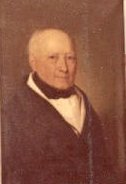Meyr's nephew
Meyr's nephew was an artistically important glass factory in Adolf near Winterberg in Bohemia . It is considered one of the oldest art glass factories in Europe.
history
Josef Meyr (* 1739 in Brünnl , Bohemia , † 1829 ) built the Adolf glass factory , named after Johann Adolf II Prince zu Schwarzenberg (1799–1888), near Winterberg in 1816 and operated a hollow glass furnace with seven ports there . He had previously built the Silberberg and Bonaventura glass factories near Buchers (today's Pohoří na Šumavě). After his death his son Johann Meyr took over the factory, his nephew Wilhelm Kralik acted as managing director. In 1830 a second furnace was added and operations were started in Eleonorenhain (two hollow glass furnaces) and Kaltenbach in Bohemia (two table furnaces) .
After Johann Meyr's death on January 17, 1841, the business was transferred to Wilhelm Kralik and Josef Taschenk, another nephew of the deceased. From this point on, the company traded under the name Meyr's Neffen and in 1854 the Ernstbrunn glass factory in Franzensthal (two hollow glass furnaces) was bought. On March 10, 1862 Josefaschek also died and Kralik took over all the business, now for the first time under the name Meyr's Neffe , which is in use today .
On May 9, 1877, Kralik, meanwhile a knight of Meyrswalden, died after being awarded the Order of the Iron Crown III. Class from the hand of Emperor Franz Joseph . His heirs Johann, Karl, Heinrich (later known as Wilhelm Kralik Sohn ) and Hugo Kralik Ritter von Meyrswalden took over all of the factories, but in 1881 there was a division and the factories in Adolf, Kaltenbach and Franzensthal went under the name Meyr's Nephew , to Karl and Hugo Kralik Ritter von Meyrswalden.
In the 1870s 730 workers were already employed and the products (many of them also commissioned work for other trading houses such as J. & L. Lobmeyr ) regularly won awards at the world fairs of that time. After that, however, a gradual decline began, although Karl Kralik Ritter von Meyrswalden was characterized by progressive entrepreneurship. In 1880, for example, he created a private school for his workers and was a co-founder of the German industrial and commercial training school that opened in Winterberg in 1895.
He left his sons Albert and Rudolf with 300 workers (excluding engravers and painters), but disagreement, the First World War and the subsequent economic crisis accelerated the decline of the glassworks in Adolf. In 1922 they merged with Ludwig Moser and in 1934 the remainder fell to Česká Unionbanka.
Modern attempts at revitalization have so far failed, but the existing sample glass store could be saved and kept for future museum purposes. Several representative products from Meyr's Neffe can be found in the Passau Glass Museum today . The company's objects are also frequently represented at glass auctions, which speaks for its high popularity among collectors.
Documents
Catalog World Exhibition 1873, J. & L. Lobmeyr and Meyr's Neffe
swell
- Constantin von Wurzbach : Meyr, Johann (Meyr's nephew) . In: Biographisches Lexikon des Kaiserthums Oesterreich . 18th part. Kaiserlich-Königliche Hof- und Staatsdruckerei, Vienna 1868, pp. 136–138 ( digitized version ).
- 1830, Franz Görner: Notation on the history of the glass factory in Adolf
Web links
- Works in the Glass Museum Passau ( Memento from May 31, 2008 in the Internet Archive )



